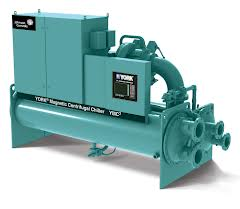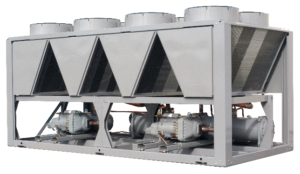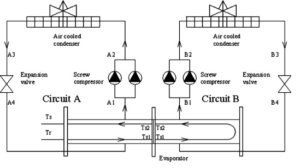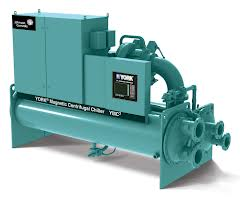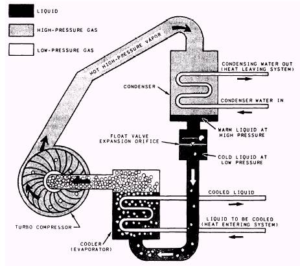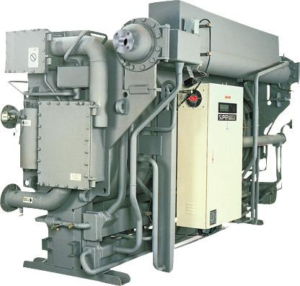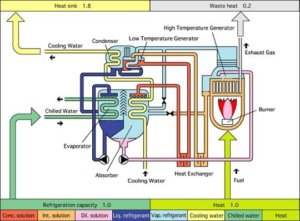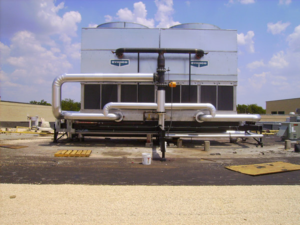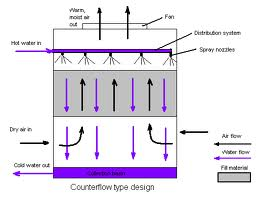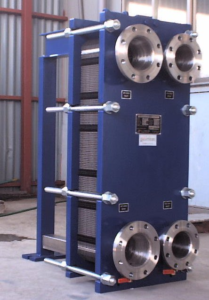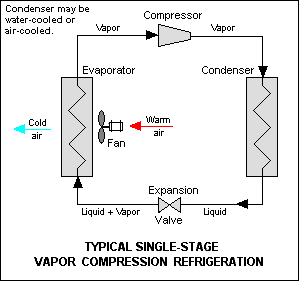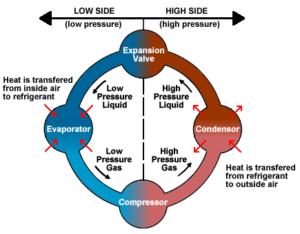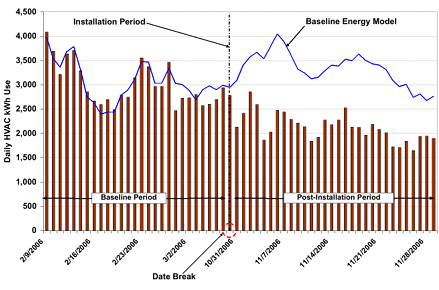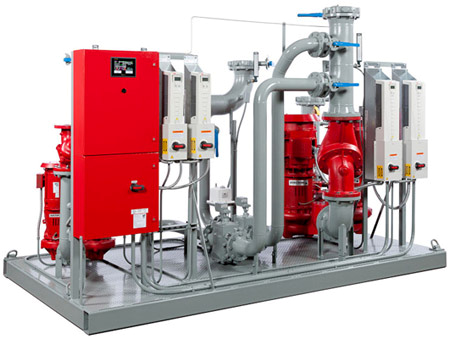The Central Utility Plant is the life blood of an HVAC system. This series will begin to give the reader an understanding of what Central Utility Plants are and will act as a spring board from which we can launch into deep control discussions. This series will cover:
- Central Plant 101
- Pumping Systems 101
- Condenser Systems 101
- Free-Cooling Systems 101
For the sake of conversation, this series of articles will focus on Chillers and their associated secondary devices (Pumps, cooling towers, plate heat exchangers). This article will be broken up into 4 sections:
- Key Terms- For those unfamiliar with CUP's, this section will help you to understand key terminology.
- Chiller Types- This will cover the three key types of Chillers (Air Cooled, Water Cooled, Absorption).
- Secondary Devices- This Section will help you understand the devices that support the chiller in delivering chilled water.
- Basic Design Theory- Now that you understand Chiller types and secondary devices, VERY HIGH level discussion around Chiller theory will be discussed.
Key Terms
- Chiller- A mechanical device that takes heat (BTU's) from one medium (water, refrigerant) and transfers it to another medium (water, air, refrigerant).
- Pumps- Mechanical devices that move water throughout a piping system using fins and/or suction mechanisms.
- Cooling Tower- A mechanical device that takes heat (BTU's) out of a medium and transfers it to the atmosphere.
- Piping- Tubing (Metal or Plastic) used to transfer water from a chiller to secondary device.
- Heat Exchanger or Plate Heat Exchanger- Transfers cooling from a Primary Source (chiller) to a secondary source (floor or building loop). Is often used to avoid pressure issues.
- Variable Frequency or Speed Drive (VSD) or (VFD)- Utilized to vary the speed or frequency of a pump, chiller, or tower motor.
- Mixing Valve- Utilized to Mix water from a primary loop into a secondary loop (more on this in advanced theory).
- Heat Trace- Electrical lining on externally exposed pipes to prevent the freezing of water.
Chiller Types
Air Cooled Chillers
Air cooled chillers rely on air to absorb heat from the cooling medium inside the chiller. Typically the air cooled chiller utilizes refrigerant that is ran through a series of condenser coils banks with vertical exhaust fans. These fans draw air through the coil transferring heat from the refrigerant to the atmosphere. The refrigerant then returns to the evaporator coil in which it absorbs the heat from the chilled water. This process follows the refrigeration cycle which will be explained in detail later in this article.
Air cooled chillers come with or without variable speed compressors and/or evaporator fans. Typically, an air cooled chiller is used for partial load conditions that do not meet the minimum tonnage requirements of a water cooled chiller.
Water Cooled Chillers
Much like Air cooled chillers, water cooled chillers rely on water to absorb heat from the cooling medium inside the chiller. Water has a greater BTU absorption and transfer rate then air. If you are feeling frisky and want to know more about BTU transfer rations you can read in detail about them here.
Since water cooled chillers need water to exhaust the heat from their cooling medium we must introduce a secondary device. While the air cooled chiller has an condenser section built into the chiller, the water cooled chiller requires a cooling tower or heat exchanger to transfer heat from the water cooled chiller to the outside environment. Water is used to absorb heat from the chiller and then is transferred to a cooling tower that uses evaporation to remove BTU's from the water. Centrifugal chillers can be and typically are larger then Air cooled chillers because water has a higher capacity of BTU's then air. This allows the water cooled chiller to remove significantly more heat from the cooling medium.
Absorption Chillers
While similar to water cooled chillers with electrical compressors, an absorption chiller relies on a chemical mixture to provide cooling. By utilizing gas or steam, an Absorption chiller is able to have a thermal compressor that absorbs heat from the water and transfers that heat to process water. While the real mechanics of how this works are beyond the scope of the article, it is safe to say that the same principles of transferring heat from returning chilled water to entering condenser water, still exists. A more detailed explanation of the process is explained here. Cautionary note: Because absorption chillers often produce significant heat, you must increase the GPM's of condenser water to compensate for absorbing the extra heat. Because of this, sequences must be considerate of the GPM demands on the condenser side for both water cooled and absorption cooled chillers.
Secondary Devices
Cooling Towers
Cooling towers take heat out of the chiller using condenser water. The heat in the condenser water is then transferred to the atmosphere via evaporative cooling. There is not much to say about cooling towers. They are relatively simple to control. I will go into greater detail in a later post discussing control strategies, common sumps, and freeze protection among other things. Below is a basic schematic of how a cooling tower works:
Heat Exchangers
Plate heat exchangers allow engineers to design a system that can transfer chilled water across large areas and up multi-story buildings without having to compensate for the pressure gain of large vertical piping runs. Additionally, plate heat exchangers allow engineers to design a system that can provide free cooling from a cooling tower or outside source to a primary cooling loop.
Pumps
Pumps and ultimately piping are the blood vessels and heart of a chilled water supply system. Without proper pumping and piping, water will not be delivered in the right quantities or may not be delivered at all. There are two types of piping for pumps: Parallel and Series. How pumps are connected to the piping infrastructure, greatly impacts how you sequence your chillers. A series system has devices that are in series or (one after another). A Parallel system, when properly implemented, can be ran independently of another chiller as it exists as a separate circuit. More on pumping strategies will come up in later articles.
Basic Design Theory
The Refrigeration Cycle
If you were to ask me, "Phil what is the one thing I NEED TO KNOW for a career in the HVAC and BAS controls industry," I would say, hands down, it is the refrigeration cycle. The Refrigeration cycle is CENTRAL to everything we do in our industry. When you fully understand the principles behind taking heat from one source and transferring it to another, not only will you understand how your cooling equipment works but you will also understand how heating works. Ultimately, the HVAC industry is a numbers game. We keep heat from transferring in and out by using certain materials and pressure methods and we add or subtract heat using certain mechanical methods. The key method is the Refrigeration cycle.
So what is it?
As you can see from the layout above, the refrigeration cycle is a method to absorb heat from one medium that is typically air or water and then transfer it using refrigerant to another medium, either air or water. Since refrigerant has different properties then water, it is able to perform state/phase changes at different temperatures and in different capacities.
First, refrigerant runs through the evaporator coil. The name of the coil is quite self-explanatory, as the refrigerant evaporates into a gas as it absorbs the heat from the medium. The refrigerant then passes through a compressor which, guess what, compresses the refrigerant back into a high pressure gas form. The refrigerant now moves to the condenser coil and is now condensed back to liquid form as the outside medium absorbs the heat from the refrigerant. The refrigerant then passes through the evaporator coil and the process happens again.
If you can understand this process, you will understand how chillers work. The whole chiller system and its secondary systems are all part of one giant refrigeration cycle. I know this is stretching it a little, as there are some aspects of water that do not function like refrigerant, but the premise remains the same.

